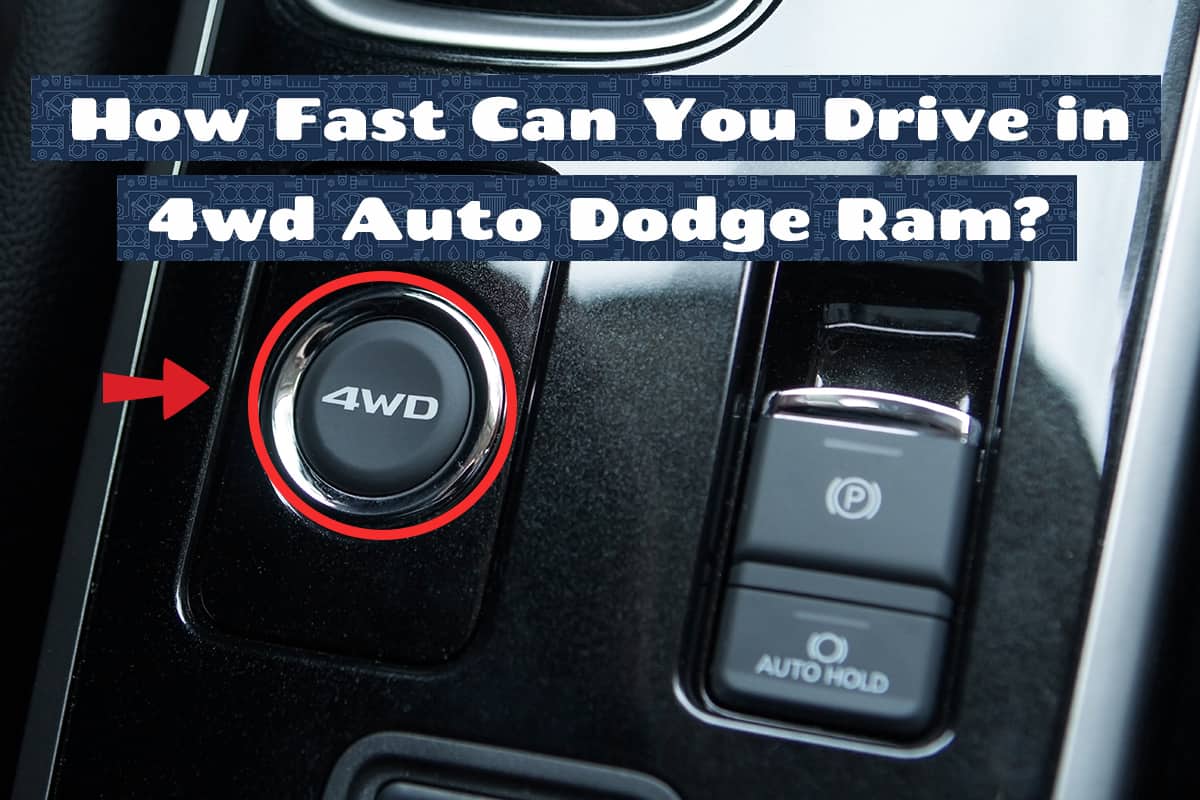Driving a vehicle equipped with a 4WD (Four Wheel Drive) system, like the Dodge Ram, offers increased traction and control, particularly on challenging terrains or during adverse weather conditions. There are multiple different modes in 4WD vehicles, with Auto creating a bit of confusion, even among Dodge Ram enthusiasts.
The maximum driving speed in 4WD Auto mode is generally between 55 and 60 MPH. However, it ultimately depends on road conditions.
In this guide, we’ll briefly cover the different 4WD driving modes and discuss driving speeds in greater detail.
Different 4WD Driving Modes

4WD systems have evolved over the year with enhanced vehicle performance across various terrains and conditions. Most 4WD vehicles, including the Dodge Ram, come equipped with multiple driving modes.
1. 4WD Auto
The 4WD Auto mode, commonly found in modern vehicles, offers a balance between two-wheel drive efficiency and the traction of four-wheel drive. It has the added benefit of maximizing fuel efficiency since 4WD naturally uses more gas. In this setting:
- The vehicle primarily functions in two-wheel drive.
- The system automatically engages 4WD when wheel slippage is detected.
- Ideal for unpredictable road conditions, like patches of ice or sudden rain.
2. 4WD High (High Range)
4WD High is the mode you’d want to activate when driving at normal speeds but need consistent four-wheel drive traction. It provides the traction of 4WD without significantly reducing the vehicle’s speed. This mode is especially beneficial for:
- Wet or slippery highways.
- Muddy roads that don’t have deep ruts.
- Gravel or loose surfaces.
- Light snow that hasn’t turned into deep drifts.
- Speeds can be comparable to regular driving conditions, often up to highway speeds of 55-65 MPH.
3. 4WD Low (Low Range)
4WD Low drastically reduces the vehicle’s speed but provides immense torque and power, beneficial for navigating particularly challenging terrains. Here’s when you’d use 4WD Low:
- Steep inclines or declines.
- Deep mud or snow.
- Rock crawling or traversing boulders.
- Towing heavy loads in challenging terrains.
- Situations where slow, powerful, and precise movements are required.
- Typically, speeds shouldn’t exceed 10-20 MPH.
4. 2WD (Two Wheel Drive)
While not a 4WD mode, 2WD is standard in many 4WD vehicles, offering:
- Better fuel efficiency for daily driving.
- Reduced wear on the drivetrain.
- Suitable for dry, paved roads or any condition where additional traction isn’t a priority.
- Suitable for speeds seen in everyday driving, including highway speeds.
5. 4WD Lock
4WD Lock is designed to “lock” the front and rear axles together, ensuring each wheel rotates at the same speed. It is not recommended for driving on dry paved roads as it can cause drivetrain stress. This provides:
- Uniform traction across all wheels.
- Ideal for sandy terrains or deep snow where consistent wheel speed is critical.
- Maximum speeds often range between 45-55 MPH.
6. 4WD Neutral
Not to be confused with the neutral gear in a transmission, 4WD Neutral is a mode where:
- The transmission is disengaged from the vehicle’s drivetrain.
- Often used when the vehicle needs to be towed without all wheels on the ground.
- It prevents potential transmission or drivetrain damage during towing.
Maximum Driving Speed in 4WD Auto Dodge Ram
The Dodge Ram, renowned for its performance, durability, and advanced 4WD system, often raises questions about its optimal and safe driving speed. This is especially true concerning the various 4WD modes.
The general recommended driving speed for 4WD Auto for the Dodge Ram is between 55 and 60 MPH. However, you may push it higher or pull it back depending on various conditions, including:
- Road Conditions: Dry, paved roads allow for higher speeds, while wet, icy, or gravel roads might necessitate slower speeds to maintain control and traction.
- Vehicle Load: The weight and distribution of cargo can affect stability. Heavier loads typically demand reduced speeds to ensure safety.
- Tire Type and Condition: Properly inflated, high-quality tires with good tread can better handle higher speeds, whereas worn-out tires might compromise stability and traction.
What Happens When You Exceed Recommended Speeds?

The ultimate goal of driving 4WD Auto—or any mode for that matter—is to drive on unpredictable roads safely. As such, if you need to crank it to 75 MPH to pass certain road conditions, you should do it.
That said, there are a few concerns if you exceed the recommended driving speed (55-60 MPH for Auto Mode, just to reiterate):
- Increased Wear and Tear: Higher speeds place added stress on the drivetrain, potentially leading to more frequent maintenance and repairs.
- Reduced Traction: At higher speeds, the chances of losing traction, especially on slippery or uneven roads, become significantly elevated.
- Decreased Fuel Efficiency: Faster speeds in 4WD can reduce fuel economy, leading to more frequent stops at the gas station.
As you can see, driving faster than the recommended speed poses a risk on your Dodge Ram, yourself, and your wallet.
FAQs
1. Can I leave 4WD Auto Mode on all the time?
There’s a debate about this. Some argue that you can leave it on for everyday driving, provided you don’t exceed the recommended driving speed (55-60 MPH). This means driving on highways is out of the question in this mode. Doing this should not cause extensive damage to your transmission.
Others argue that you should only use it during emergency situations—e.g., slippery or uneven roads. The main argument here is that 4WD Auto uses more gas than 2WD.
2. Can I turn on 4WD Auto Mode while driving?
Yes, most modern vehicles equipped with 4WD Auto Mode allow for a “shift on the fly” feature. This means you can engage or disengage 4WD Auto without having to stop the vehicle. If you’re driving and encounter a patch of road that looks icy or muddy, you can safely switch to 4WD Auto Mode for enhanced stability and traction.
The only stipulation is that you should engage 4WD Auto when driving below 60 MPH. If you switch to this mode on the highway, for instance, you increase the risk of damaging your truck’s transmission system.
3. What are the disadvantages of a 4WD car?
While 4WD vehicles offer distinct advantages, particularly in terms of traction and off-road capabilities, there are some disadvantages to consider:
- Fuel Efficiency: Generally, 4WD vehicles consume more fuel than their 2WD counterparts. The added weight of the 4WD components and the power needed to operate all four wheels simultaneously can reduce miles per gallon.
- Maintenance Costs: 4WD systems introduce more moving parts, such as transfer cases and additional differentials. Over time, these components may need maintenance or repairs, potentially leading to higher servicing costs.
- Vehicle Weight: The added components for the 4WD system increase the overall weight of the vehicle. This could affect acceleration, braking distance, and general maneuverability.
- Complexity: For drivers unfamiliar with 4WD systems, there’s a learning curve involved in understanding when and how to use the different modes effectively. Incorrect use in certain conditions might lead to reduced performance or even potential damage.
4. How fast can I drive in 4WD Low?
In 4WD Low or 4WL, your vehicle is set to handle challenging terrains by emphasizing power and torque over speed. This mode is best used in situations like steep inclines, rock crawling, or deep mud.
The recommended driving speed for 4WL is typically between 10-20 mph. Exceeding this speed can pose risks, including loss of vehicle control and potential damage to the drivetrain due to the high torque applied. Driving too fast in 4WL also increases the strain on your vehicle’s components and may lead to premature wear or failure.







